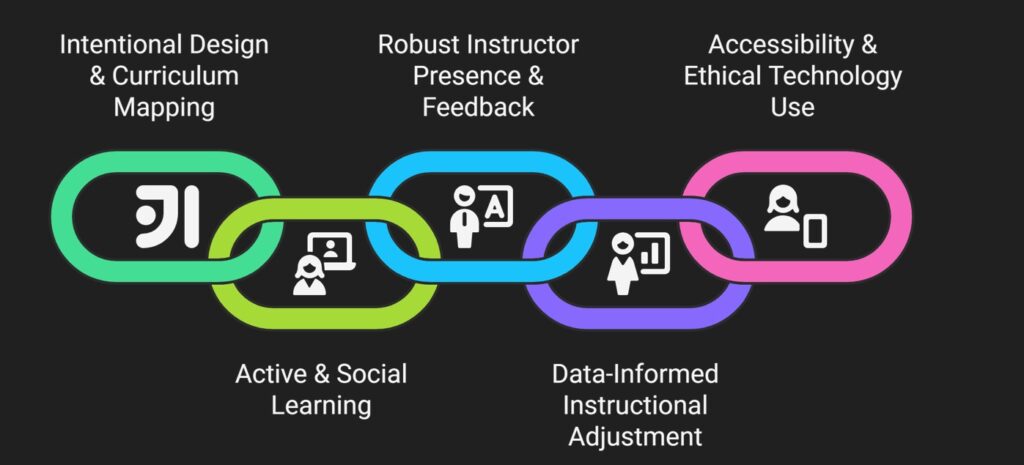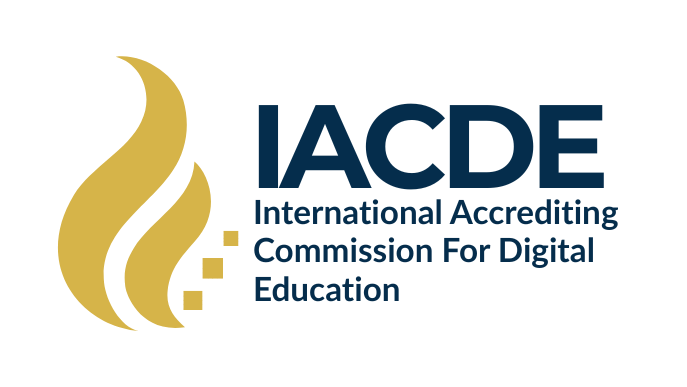In the rapidly evolving landscape of education, simply transferring a physical classroom online is a recipe for disengagement. Effective digital pedagogy is a distinct discipline—a strategic blend of art and science designed to foster deep, meaningful learning in a virtual environment.
At the International Accrediting Commission for Digital Education (IACDE), we evaluate how institutions design and deliver digital learning experiences as part of our Core Standards Framework. Drawing on our analysis of leading global programs, we’ve identified five instructional pillars that represent the foundation of effective digital pedagogy within our broader accreditation standards.

Pillar 1: Intentional Design and Curriculum Alignment
The Principle: Learning doesn’t happen by accident. In a digital space, every element—from a single video to a major assignment—must be intentionally designed to achieve specific learning outcomes.
- Best Practices:
- Backward Design: Start with the end in mind. Define what students should know and be able to do (learning outcomes), then design assessments to measure them, and finally create learning activities that lead to success.
- Chunking: Break down content into manageable, focused segments (micro-lessons). This respects cognitive load and improves knowledge retention.
- Universal Design for Learning (UDL): Build in multiple means of engagement, representation, and expression from the start to create an inclusive learning environment for all.
Pillar 2: Active and Collaborative Learning
The Principle: Passive consumption of content is the enemy of deep learning. Digital pedagogy must be built around activities that require students to interact with the material, the instructor, and each other.
- Best Practices:
- Structured Collaboration: Move beyond simple discussion forums. Use structured peer review, collaborative problem-solving in breakout rooms, and group projects using digital whiteboards (e.g., Miro, Jamboard).
- Authentic Assessment: Design assessments that mirror real-world tasks. Instead of a multiple-choice test on project management, have students use a tool like Trello or Asana to plan and execute a mini-project.
- Synchronous & Asynchronous Balance: Use live sessions for Q&A, debate, and community-building, while using asynchronous time for deep reflection and individual work.
Pillar 3: Instructor Presence and Meaningful Feedback
The Principle: In a digital environment, “out of sight” cannot mean “out of mind.” A strong and consistent instructor presence is the single most critical factor in reducing dropout rates and building a community of trust.
- Best Practices:
- Proactive Communication: Establish a regular rhythm of communication through weekly announcements or short video updates.
- High-Touch Feedback: Provide timely, specific, and constructive feedback on assignments. Use audio or video feedback to add a personal, human touch that text alone cannot convey.
- Virtual Office Hours: Host regular, accessible office hours via video conferencing, making yourself available for support and mentorship.
Pillar 4: Data-Informed Improvement and Responsiveness
The Principle: The digital classroom is a rich source of data. Effective educators use this data not for surveillance, but for insight—to identify struggling students and refine their teaching methods in real-time.
- Best Practices:
- LMS Analytics: Monitor Learning Management System (LMS) dashboards for indicators of engagement, such as login frequency, content access, and participation in discussions.
- Formative Assessment: Use low-stakes quizzes, polls, and one-minute papers to quickly gauge student understanding before moving on.
- Adaptive Teaching: Be prepared to pivot. If data shows a concept isn’t landing, host an extra review session or create a new resource to address the gap.
Pillar 5: Accessibility and Ethical Use of Technology
The Principle: Equity is non-negotiable. Digital learning must be accessible to all students, regardless of ability or circumstance, and technology must be used in ethical, privacy-conscious ways.
- Best Practices:
- Accessibility Compliance: Ensure all video content has accurate captions, images have alt-text, and documents are structured for screen readers (WCAG guidelines).
- Tool Selection: Choose educational technology that prioritizes student data privacy and security. Avoid tools that require excessive permissions.
- Digital Equity: Be mindful of students’ technology access and bandwidth. Offer alternative ways to access materials and complete assignments when possible.
Together, these pillars support IACDE’s six Core Values—Integrity, Innovation, Student Success, Global Collaboration, Continuous Improvement, and Digital Trust (Data Security & Compliance). They represent how accredited institutions demonstrate excellence in teaching and learning as part of IACDE’s broader Core Standards Framework.
Building on a Foundation of Excellence
These five pillars are not a checklist but an interconnected framework. Excellence in digital pedagogy is a continuous journey of alignment, engagement, support, reflection, and inclusion. Institutions that master these areas are not only providing a superior education but are also building a strong foundation for quality assurance and accreditation.
This pedagogical framework, developed by IACDE’s academic experts, informs our accreditation standards for institutional effectiveness in digital learning. It has been reviewed and approved by the IACDE Accreditation Commission, ensuring alignment with global best practices and educational quality benchmarks.
About IACDE
The International Accrediting Commission for Digital Education (IACDE) is an independent, private global quality-assurance body dedicated to accrediting online, hybrid, and technology-enhanced education providers. Through its Core Standards Framework and peer-review process, IACDE upholds six Core Values—Integrity, Innovation, Student Success, Global Collaboration, Continuous Improvement, and Digital Trust.
Learn more at iacde.org.



Comments are closed